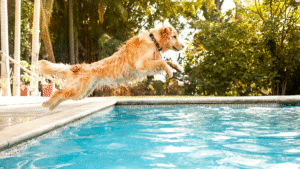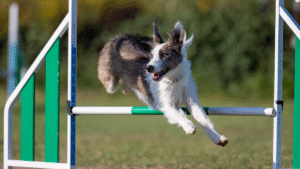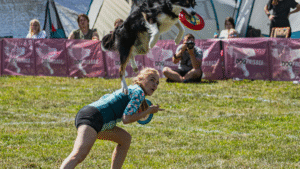You’re not alone if this scenario sounds all too familiar. The doorbell rings. You welcome your guests inside. Before they’ve even said hello, your dog comes zooming toward them like a Humanoid Pet Rocket—jumping, bouncing, and flailing in excitement.
You’re just grateful your guests like dogs, because it’s an awkward situation all around. You love your pup to pieces, but dealing with an enthusiastic dog who jumps on guests can be embarrassing, frustrating, and even dangerous.
Thankfully, there’s an easy and surprisingly effective trick to stop your dog from jumping on guests—and it doesn’t require punishment or harsh corrections.

Why Dogs Jump on People
Before we get to the solution, let’s start by understanding why dogs jump on people in the first place. Dogs communicate and express excitement through body language that’s very different from ours. They don’t jump because they’re trying to be bad or disobedient—they’re just over the moon to see you.
Here are a few common reasons dogs jump on people:
1. Excitement and greeting behavior – Face-to-face greetings are a natural way dogs say hello in the canine world. Since humans are taller, jumping helps your dog reach your face.
2. Attention-seeking – If your dog gets attention when they jump—even negative attention—they’ll learn that jumping works.
3. Lack of impulse control – For young puppies and highly excitable dogs, impulse control isn’t fully developed yet. They’re literally incapable of not showing excitement.
4. Reinforcement history – If you’ve ever petted, talked to, or even laughed at your dog when they jumped, they learned that jumping is a great way to get attention.
Knowing that jumping on people is a learned—and often reinforced—behavior is half the battle. From there, you can teach them a new, better behavior to get what they want.
The One Trick: Train Your Dog That “Four Paws on the Floor” = Attention
Ready for the one trick to help your dog stop jumping on guests?
Here it is: Only give your dog attention when all four paws are on the floor.
That’s it.
This approach is based on positive reinforcement training. You’re teaching your dog that calm, grounded behavior is the only way to get what they want—your attention and affection. If they jump, they get nothing. If they stay on the floor, they get love, treats, and praise.
Before long, your dog will learn that the fastest and easiest way to earn your attention is to keep all four paws on the ground.

Step-by-Step Guide to Stopping Jumping on Guests
Let’s break down exactly how to use this method to stop your dog from jumping on guests.
Step 1: Control the Situation
Start in a setting where you can manage your dog’s behavior. If they go ballistic every time someone walks in, that’s a sign it’s time for training—not real-life practice.
-
Use family members or friends to help with controlled training sessions.
-
Keep your dog on a leash if needed to prevent unwanted behavior without physical correction.
-
Have treats ready—small, soft, and irresistible ones work best.
Step 2: Ignore Jumping Behavior
This is the hardest part: when your dog jumps on you, completely ignore them. Don’t yell, push, talk, or even make eye contact.
Even negative attention can be rewarding to a dog craving interaction. Calmly turn away and wait them out.
Step 3: Reward Calm Behavior Immediately
The instant your dog’s paws touch the ground, reward them with calm praise or a treat. Timing is crucial—the reward must happen as soon as the desired behavior occurs.
Say something like “Good job, down” or “Nice and calm” in a soft voice. The idea is to make keeping paws on the floor the most rewarding thing your dog can do.
Step 4: Practice the “Sit for Greetings” Rule
Once your dog masters keeping all four paws down, add a verbal cue like “sit.” Teach your dog that sitting is the only way to get attention or greet guests.
-
When guests arrive, ask your dog to “sit.”
-
If they do, the guest can greet them.
-
If they don’t, the guest should ignore them until they calm down.
Everyone who interacts with your dog must follow this rule. If even one person ignores it, your training can backslide.
Step 5: Practice with Real Guests
Once your dog is consistent with the “four paws on the floor” rule, it’s time to test it with actual visitors.
-
Let guests know ahead of time what to do. Ask them to ignore your dog if they jump and to only give attention when your dog is calm or sitting.
-
Keep greetings short and structured at first.
-
Gradually increase the challenge by having more guests, ringing the doorbell, or adding excitement.
Consistency will pay off. Within a few weeks, most dogs learn to greet politely.

Bonus Tips to Reinforce Calm Greetings
While the “four paws on the floor” trick is incredibly effective, a few extra strategies can help make training even smoother.
1. Set Up a Station or “Place” Command
Teaching your dog to go to a mat or bed when guests arrive gives them a clear, safe job to do.
-
Train the “place” command by luring your dog to a mat and rewarding them for staying there.
-
When guests arrive, send them to their “place.”
-
Reward them for staying calm as the guest enters.
Over time, your dog will learn that the sound of the doorbell means calm behavior and rewards—not chaos.
2. Tire Out Your Dog Before Guests Arrive
A tired dog is a well-behaved dog. Take your pup for a good walk or play fetch before guests come over. It helps burn off excess energy that might otherwise turn into jumping.
3. Stay Calm Yourself
Your dog picks up on your emotions. The calmer and more relaxed you are, the better they’ll behave. If you get tense, shout, or move frantically, it signals excitement to your dog. Keep your tone soft and your movements slow—calm behavior is contagious.
4. Avoid Physical Punishment
Kneeing, pushing, or yelling might seem effective in the moment, but it can cause fear, confusion, and even aggression. It also doesn’t teach your dog what to do instead. Stick with positive reinforcement.
5. Reward Quietly
When you reward calm behavior, do it quietly and gently. Loud praise or high-pitched excitement can trigger more jumping. Keep your rewards calm to encourage calmness in your dog.
What to Do If Your Dog Keeps Jumping
If your dog is still struggling to stop jumping despite consistent training, it may mean:
-
You’re not rewarding quickly enough (timing matters).
-
Guests or family members are inconsistently reinforcing the behavior.
-
Your dog is too overstimulated—try practicing farther from the door first.
If needed, schedule a few sessions with a positive reinforcement dog trainer. A professional can pinpoint what’s causing the issue and create a custom plan for your dog’s personality.

Why Positive Reinforcement Training Works Best
Dogs learn through association. They repeat behaviors that are followed by rewards and avoid those that aren’t. Positive reinforcement training focuses on teaching your dog what you want them to do, instead of punishing what you don’t.
This method builds trust, strengthens your bond, and makes learning fun. When your dog realizes that calm, polite behavior earns love, treats, and attention, they’ll naturally choose it—even when guests are at the door.
Consistency Is Key
The real secret to stopping jumping behavior is consistency. Every single person who interacts with your dog must follow the same rule:
-
Ignore jumping.
-
Reward calm.
If even one person rewards jumping (by petting or talking), it undermines your training. Make sure everyone in your household and all visitors know the plan.
Patience, consistency, and positive reinforcement are the three ingredients that make behavior change permanent.
The Bottom Line
The next time your dog jumps on guests, remember—it’s not about dominance or bad manners. It’s about excitement and learned behavior. By consistently rewarding your dog only for “four paws on the floor” and ignoring jumping, you can teach them to greet people calmly and politely.
It takes time and practice, but any dog—of any age or breed—can learn this skill.
A well-behaved dog that greets guests calmly makes for a more peaceful home and strengthens the bond you share with your furry best friend.
- 5 Cheap Alternatives To Dog Training Equipment - November 12, 2025
- Homemade Calming Spray To Help Dogs During Training - November 12, 2025
- 7 DIY Dog Training Tools You Can Make From Household Items - November 12, 2025
